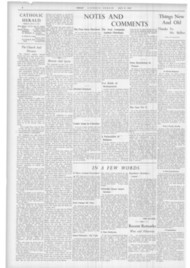Page 13, 9th July 1937
Page 13

Report an error
Noticed an error on this page?If you've noticed an error in this article please click here to report it.
Tags
Share
Related articles
Pope Opens Historic Synod
Cockfosters Benedictines Make
Worship
Roman Chasuble
Of A Catholic City Centre
Propaganda And The Artist
Catholic Academy Opened By Fr. D'Arcy
Surrealism Used In Liturgical Art
From a Staff Reporter " We pile up bric-a-brac, admire theatrical vestments, and are content to worship the Blessed Sacrament amid what would disgrace a third-rate museum, making liturgical art a matter of litter," said Fr. Martin D'Arcy when he opened the exhibition of Catholic Art in Cathedral Hall on Tuesday.
Those great changes that have occurred both in the attitude to art and among artists themselves have made it impossible for the Catholic not to take sides, he said, followed up his challenging prelude with a brilliant excursion into the nature of surrealism; the relation between art and a philosophy of life; the place of propagandist art and the place of Catholic art today.
Commenting on the recent exhibition of the Artists' International Association in Grosvenor Square, he described it as a series of rooms " dedicated to Communist and surrealist work " and concerned with the consolidation of " a united front and the breaking down of the bourgeois idea of non-intervention."
Art and Propaganda " When one thinks how within the lifetime of many here, the prevailing theory of art was that it existed with an end of its own and was prostituted if used for propaganda, religious or political, and that now artists despise those who stand apart from political and social strife, it is easy to see that we cannot be indifferent," continued Er. D'Arcy.
"Moreover, there can be no doubt that modern 1770 vemertts of art are swayed in a remarkable way by philosophies of life.
"Mr. Herbert Read. for instance, interprets poetry and painting in terms of pyscho-analytic theory, the modernist condemns many forms which have pleased the public as dead and bourgeois, and in a book I have been reading on surrealism, I find its object is to realise the irrational elements in man. ' le speaks with the vocabulary of the gieat vital constants, sexual instinct, feeling of death, physical notion of the enigma of space.'" Surrealist Proverbs And quoting again on the subject of surrealism, Fr. D'Arcy went on in the words of a commentator: " ' The transposition of the surrealist act to the political plane has had on contemporary youth, the result of bringing them to the recognition of the U.S.S.R. to the consideration that in theory the Soviet regime is a livable regime, perhaps the only one.'
" The surrealists have their proverbs,
such as Elephants arc contagious," When the reason is away the smiles will play' and that Cold meat lights no fires,' They mean perhaps that elephants, who are symbolical of heavy stupidity, are contagious, and so we have to beware that our stupid prejudices do not spoil the efforts of our artists here tod-ky to be alive, and that cold meat lights no fire because in order to do anything worth while there must be belief, and a strong, warm belief.
Catholic Viewpoint " These then are the many questions which concern us in the changes in artistic views, which raise a number of such questions, as whether it is right that Catholic artists should take to propaganda, as so many of the best non-Catholics do now, whether there should be a greater use of patrons in art or less, and how far our artist should work in with the economic and financial forces which govern business, and lastly whether we are able to create a new popular art.
" For the answer to at least one of them you have the evidence of the present exhi bition. This is devoted to liturgical art, and here there is a purpose which should never be disguised.
"The artist has to live in the Church in his imagination, and to see both architecturally. and for its equipment. what can best serve the end for which the Christian religion exists. The Guild of Catholic artists and this exhibition have for a purpose to show how God may be truly worshipped with fitting material, and how in their work the saying of St. Augustine may be verified of Truth ever ancient and ever new.
"I hope, too, that this exhibition may deepen and quicken the appreciation of the Catholic public. We, perhaps, more than others, are inclined to be over-conservative in our tastes and to be childish in our artistic likes when old in years."
Catholic Surrealism The exhibition itself lived up to the high standards set by Fr. D'Arcy's speech. It was modern in style, and could be accused of no conservatism. It was also strictly liturgical in spirit, much of it influenced by Byzantine traditions.
Geoffrey Webb's work was probably most outstanding and created widest interest. His contributions included the centrepiece of a carved and gilded reredos for the Lady Altar of Broadstairs Church, and a conventional triptych of the English martyrs for Ushaw College.
Margaret Smith's conception Of the strong St. Christopher, upstanding like a tree, gave much evidence of the Gill influence, and was perhaps the most imaginative piece of sculpture in the exhibition. G. Houghton Brown showed by a beautiful relation of line and form in Jesus Falls that surrealism is not all propaganda, and Joan Morris had several canvasses which use modern abstract tendencies to their greatest advantage.
Other " big " names who all contributed work ot' the usual high standard were Eric Gill, the late Mark Symons, nuns of Stanbrook Abbey. and Peter Anson. Missionary work, too, was represented by an appealing Indian child's painting on leather of a Red Indian Si. Francis preaching to the birds and animals of Grand Canyon.
blog comments powered by Disqus
















